Everything you need to know about SD memory cards
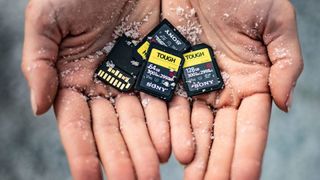
The vast majority of cameras – at least, those aimed at beginners and enthusiasts – use SD-format memory cards for recording images and videos. Over the years these have evolved to meet the demands of increasingly advanced cameras, from the higher megapixel counts of sensors to faster bursts rates and 4K video recording.
A consequence of this is that today’s cards bear many different indicators as to how they can be expected to perform, which can make choosing a card confusing to those unfamiliar with the terminology. We're here to demystify the process and help you find the best card for your camera, so here are the main things to consider.
Type and brand
The first thing to look for is whether a specific card is compatible with your camera.
Assuming your camera uses the SD format, it should be compatible with the two main types of cards manufactured today, namely SDHC (Secure Digital High Capacity) and SDXC (Secure Digital eXtended Capacity).
Older cards that are simply marked SD will typically work with today’s cameras too, although they're no longer produced, as the demands of the latest models exceed their capabilities.
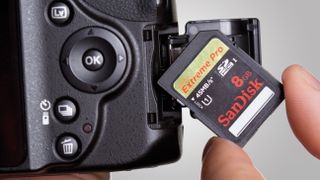
The best way to check what your camera will and won’t accept is to look up the camera’s specifications in the manual (or the equivalent page on the manufacturer’s website).
All SDHC and SDXC cards have a small tab at the side that prevents a card’s contents from being changed in any way – if you slide this tab down you won’t be able to record anything to or delete anything from the card, and this is a useful way to secure your images and videos, particularly once your card is full. Sometimes this tab can be moved slightly when you're inserting a card into your camera. If you get an error message when trying to take an image, take the card out and check the tab isn't in the 'locked' position.

Other types of SD cards come in smaller variants, such as microSDXC. These are typically used in smartphones, although they often come with SD-sized adapters that allow them to be used in cameras and card readers.
Lexar and Sandisk are the dominant players in the market, although Integral, Kingston and Transcend produce perfectly sound alternatives that may be cheaper, while there are also options from well-known brands such as Toshiba and Samsung. Whichever brand you decide to go for, only buy from a reputable seller, as there are unscrupulous outlets offering counterfeit cards.
Capacity
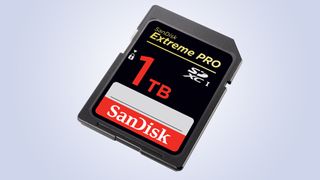
Memory cards come in a wide range of capacities, and this is reflected in their price. All cards with a capacity of 32GB and under fall into the SDHC camp, while cards sized at 64GB and over are classed as SDXC. You’ll soon be able to buy cards in the latter variety at capacities of up to 1TB – the same as a basic hard drive – although this is well beyond what most people need (and indeed, can afford). The most common types of cards are 16GB, 32GB and 64GB.
How large a card you need depends on what you intend to use it for. Someone using a compact camera with a 12MP sensor, for example, should get along fine with a 16GB card if they only intend to capture JPEGs on an occasional basis. If your camera is equipped with a larger sensor, however, and you want to capture raw files, videos or many bursts of images, you're likely to find that a 16GB card fills up far too quickly.

Most people find that opting for a handful of moderately sized cards is a better option than using a single larger one. This makes sense from the perspective of security – if something goes wrong with the card, for example, it’s good to know that not all your images and videos are at risk – but it’s also a good idea where organisation is concerned. An increasing number of cameras now offer two card slots, which is another reason to invest in multiple cards rather than just
Speed and performance

Many of the markings on a memory card relate to its performance in terms of transfer speeds. We’ll take a look at each of these in turn.
Speed Class
The figures themselves are derived from the measurement in MB/s. So a Class 2 card has a minimum sustained write speed of 2MB/s, while a Class 4 card ups this to 4MB/s and so on. As a general rule the faster the better, although for standard HD video recording you shouldn't need anything too speedy.
Class 10 cards are ideal for Full HD video but if your camera supports 4K video recording you may want to go for a card that also shows its UHS Class.
Ultra High Speed (UHS) Class
SDHC and SDXC cards typically show the number 1 or 3 inside a U shaped icon. Where you see this, you can be sure that the card conforms to the newer Ultra High Speed (UHS) standard.
Like Card Class, this provides you with an idea of minimum guaranteed sustained write speeds. A ‘1’ inside the U indicates a minimum sustained write speed of 10MB/s while a ‘3’ indicates a speed of 30MB/s. As the latter type is faster than standard Class 10 cards, these are better suited to more data-intensive operations such as 4K video recording.
Trying to record high resolution video to slow cards can cause the camera to stop recording, potentially even after just a few seconds, so it’s a good idea to think about how you imagine you will use your camera for video when buying a card.
It’s now possible to find cards that conform to UHS-I and UHS-II standards, and you can tell which one applies to a given card by checking whether it is marked with a single numeral (I) or two (II). UHS-II cards also have an extra row of contacts at their rear, and they promise even faster transfer speeds than UHS-I, although purchasing one only really makes sense if your camera is one of the recent few that supports this interface.
Currently, most cameras support the UHS-I interface but not the newer UHS-II one. You can, however, still benefit from their faster read speeds with a UHS-II card reader when transferring images to a computer.
Should you do decide to go for one, you’ll be pleased to learn that they are backward compatible with cameras that only support UHS-I, although you won’t realise their speed benefits inside such cameras.
Video Speed Class
In addition to Speed Class and UHS Speed Class, there is now a newer Video Speed Class.
This has been developed with 8K cameras and high video frame rates in mind, and so it’s not something that many will necessarily need to take advantage of, particularly as 8K video recording hasn't yet been incorporated into consumer-level products. Nevertheless, as these are set to be available shortly, it’s useful to understand how these will be classed.
The good news is that it’s just as easy to understand as Speed Class: so, a card marked V6, for example, promises a minimum sequential write speed of 6MB/s. These will also be available in V10 and V30 flavours to match the demands of 4K video recording, as well as V60 and V90 options intended for higher-resolution 8K shooting.
?Need a CompactFlash, XQD or alternative card
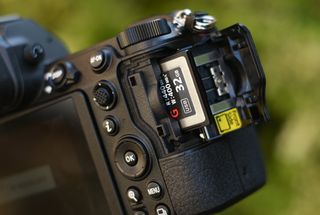
Not all cameras use SD-type cards. The CompactFlash format is still used by some professional DSLRs, while slots for the newer CFast and XQD formats have also started to appear inside some models like the Nikon Z7.
Such cards still show capacity in the same way as SDHC and SDXC cards, and will typically have their read speeds marked in the same way too, although they do not use the same speed classes as SD cards.
With regards to read and write speeds, the fastest CompactFlash cards currently available are marked UDMA 7. Such cards have a maximum transfer rate of 167MB/s, which is slightly faster than the 133 MB/s limit of the previous UDMA 6 format.
Physical protection

Some cards claim to be protected against water, shock and x-rays to some degree, and may work in more extreme temperatures than standard cards. If you imagine you’ll be working in particularly demanding conditions, or if you just want peace of mind, you may want to look out for these.
The more professional offerings in a manufacturers line will typically have these as standard. Of course, if you do intend to use your camera in particularly harsh environments, it’s a good idea to check that the camera, battery and any other equipment you plan on using will remain operational – again, your manual is the best place to check this.
File recovery software

Losing images and videos is all too easy, be it by your own hand or because of file corruption. Some cards ship with software that could potentially recover such files, although you may find success with third-party software too.
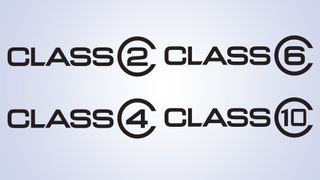
Many of today’s SDHC and SDXC cards are marked with a figure such as 2, 4 6 or 10 in an almost complete circle, and this indicates the minimum sustained write speed for that card. This is known as the Speed Class and it’s a useful way to assess whether a card is suitable for whatever video recording you may have planned.
Card reader
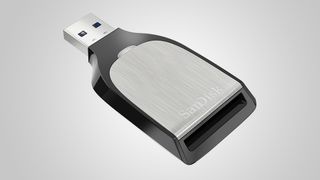
Check to see whether you need to use a specific card reader with your card in order to take advantage of the fastest read speeds. Otherwise, a more standard card reader – be it one that’s incorporated into a computer or an external device – will act as a bottleneck here.
5 SDXC cards tested for 4K recording and burst shooting
We tested these cards’ read/write speeds for both images and video, recording overall transfer times and read/write fluctuations which could result in dropped video frames. All these cards are UHS-I types, with a single row of contacts on the back. UHS-II SD cards have a second row of contacts, offering up to three times the theoretical speed, though you need a compatible camera.
1. SanDisk Extreme Pro 64GB
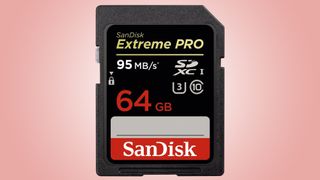
SanDisk’s contender produced a blistering 83.3MB/s video write rate, and it wrote images at a sustained 56.4MB/s with no speed dips, making it the smoothest performer here
2. Samsung Pro+ 64GB
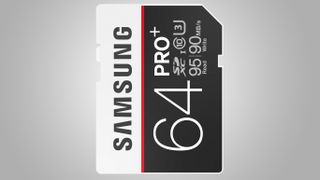
The Pro+ turned in the fastest outright image write rate of 58.2MB/s, but not without some minor speed fluctuations. Read performance is faultless, however, as is video write speed.
3. Kingston SDXC UHS-I U3 64GB
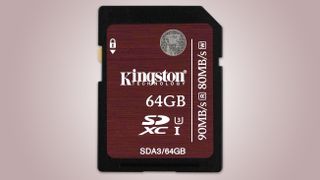
Kingston’s fastest SD card managed a whopping 84.1MB/s when writing video, though transferring multiple image files resulted in a mediocre 42.8MB/s, with lots of speed fluctuations.
4. Transcend SDXC UHS-I U3 64GB
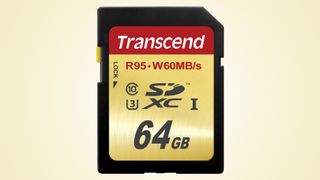
Despite sharing the same speed class ratings as SanDisk’s entry, this card only managed an erratic 36.8MB/s average image write speed. 64MB/s when writing video isn’t too shabby, though.
5. Lexar Professional 633x SDXC UHS-I 64GB

It may only have a UHS Class 1 speed rating, but this card’s read rates are a match for the competition. Write speeds of 53MB/s with video and 36.7MB/s with images trail the pack, though.
Alternatively, you could get a microSD card

Samsung Evo Plus
If you want to invest in a card that you can use across a number of devices, you might want to look at a microSD card like Samsung's new Evo Plus range. Coming complete with a full-size SD card adapter, the cards feature the brand's NAND technology with read speeds at 100MB/s and write speeds as quick as 90MB/s. As well as this, the card is waterproof, freezeproof, X-Ray proof and magnetic proof.

Comments
Post a Comment